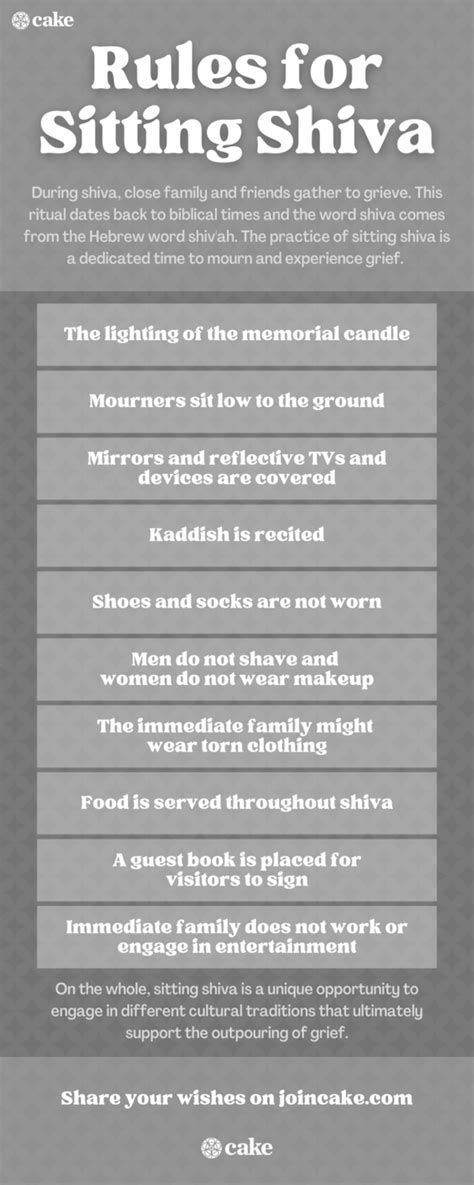The Shiva Protocol is a profound system of rituals and practices traditionally observed by Jewish individuals during the mourning period of a loved one. However, its principles and wisdom can be universally applied, offering solace and guidance to non-Jews seeking comfort and healing in moments of grief.

Understanding the Shiva Protocol
The Shiva Protocol encompasses a set of customs designed to provide a sacred space for grieving, honor the memory of the deceased, and promote communal support. It includes:
- Establishing a Shiva House: The home of the deceased or a designated space becomes a sanctuary for mourning, where family and friends gather to offer condolences and support.
- Sitting Shiva: For seven days, close relatives observe a period of sitting on low chairs or cushions, symbolizing their state of mourning.
- Reciting Kaddish: Special prayers are recited daily to honor the deceased and provide spiritual comfort to the mourners.
- Offering Comfort: Visitors bring food, flowers, or other gestures of support to express their sympathy and share the burden of grief.
- Ending Shiva: The conclusion of the mourning period is marked by a final service and the removal of the mirrors from the grieving family’s home, signifying the transition back to normalcy.
Applying the Shiva Protocol for Non-Jews
While the specific rituals of the Shiva Protocol may not be identical for non-Jews, the underlying principles can be adapted to create a meaningful and healing experience:
Create a Sacred Space: Designate a special area in your home or a peaceful outdoor space as a place for reflection, solitude, and the company of loved ones.
Practice Active Grieving: Allow yourself adequate time and space to process your emotions fully. Engage in activities such as journaling, talking to trusted friends, or seeking professional counseling if needed.
Seek Support and Community: Reach out to family, friends, colleagues, or support groups who can provide emotional support and practical assistance during this challenging time.
Honor Your Lost Loved One: Create a memorial or tribute that reflects their life, values, and impact on your own. This could involve planting a tree, creating a scrapbook, or engaging in a meaningful activity in their honor.
Benefits of the Shiva Protocol
Emotional Healing: The Shiva Protocol provides a structured framework for expressing and navigating the complexities of grief. It allows time and space for the mourner to fully process their emotions and begin to heal.
Community Support: By gathering in a supportive environment, mourners can share their pain, offer comfort to each other, and foster a sense of belonging during a time of isolation and loss.
Spiritual Growth: The Shiva Protocol encourages reflection on the meaning of life and death and provides opportunities for spiritual development and connection.
Table 1: Key Aspects of the Shiva Protocol
| Aspect | Description |
|---|---|
| Establishing a Shiva House | Creating a sacred space for mourning |
| Sitting Shiva | Observing a period of deep grief for seven days |
| Reciting Kaddish | Saying special prayers to honor the deceased |
| Offering Comfort | Providing support and sympathy to the mourners |
| Ending Shiva | Concluding the mourning period and transitioning back to normalcy |
Practical Applications for Non-Jews
Enhance Employee Support: Companies can adopt principles of the Shiva Protocol to create bereavement policies that provide employees with paid time off, access to counseling services, and a supportive work environment during times of loss.
Create Compassionate Hospitals: Healthcare professionals can integrate elements of the Shiva Protocol into palliative and end-of-life care to foster empathy, respect for patients and families, and a sense of community within the hospital setting.
Support Bereaved Children: Schools and community organizations can develop programs based on the Shiva Protocol to provide a safe and nurturing environment for children who have experienced the loss of a loved one.
Table 2: Innovations in Shiva Protocol Applications
| Application | Description |
|---|---|
| Virtual Shiva Houses | Creating online platforms for mourners to connect and share support |
| Grief Ritual Design | Customizing rituals and practices to meet the unique needs of diverse cultural groups |
| Therapeutic Shiva Workshops | Facilitating group therapy sessions that incorporate principles of the Shiva Protocol |
Conclusion
The Shiva Protocol, while rooted in Jewish tradition, offers universal principles and practices that can guide non-Jews through the challenging journey of grief. By embracing the principles of sacred space, active grieving, support systems, and remembrance, we can create meaningful and healing experiences during times of loss.
Additional Resources
Table 3: Statistics on Grief and Bereavement
| Statistic | Source |
|---|---|
| 1 in 5 adults in the United States experience a significant loss each year | American Psychological Association |
| 2.5 million Americans die annually | Centers for Disease Control and Prevention |
| The average person attends 4 funerals in their lifetime | National Funeral Directors Association |
Table 4: Recommended Reading for Non-Jews on Grief
| Title | Author |
|---|---|
| “Grief Works: Stories of Life, Death, and Survival” | Julia Samuel |
| “The Year of Magical Thinking” | Joan Didion |
| “Healing after Loss: Daily Meditations for Working Through Grief” | Martha Whitmore Hickman |
Call to Action
If you or someone you know is experiencing grief, consider exploring the principles of the Shiva Protocol. By creating a sacred space, seeking support, and honoring the memory of your loved one, you can navigate the challenging journey of bereavement with compassion and resilience.
